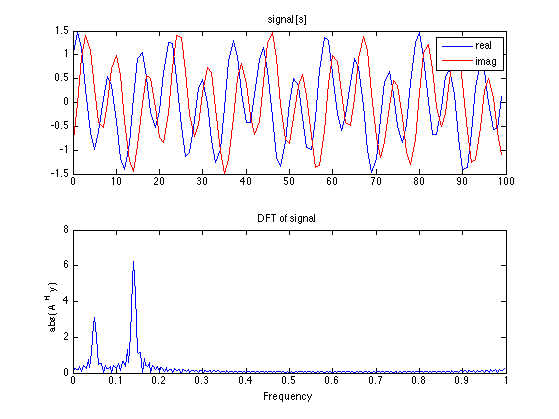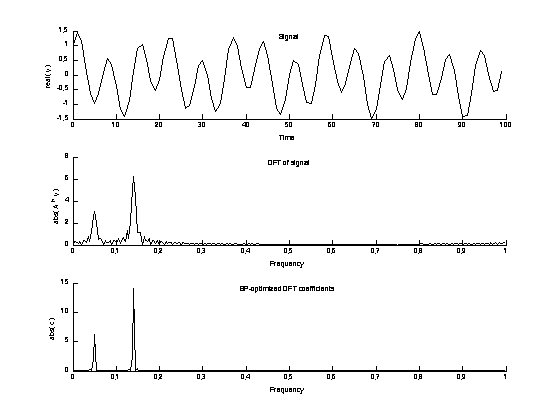Example: Basis pursuit (BP) with the DFT
Sparse representation of complex sinusoids using basis pursuit (BP) with zero-padded DFT.
Contents
Misc
clear
close all
I = sqrt(-1);
Make signal
N = 100; % N : signal length n = 0:N-1; f1 = 0.05; f2 = 0.14; y = 0.5*exp(I*2*pi*f1*n) + exp(I*(2*pi*f2*n - pi/3)); % y : complex sinusoid
Define transform
Oversampled DFT
Nfft = 256; % Nfft : FFT length (including zero-padding) [A, AH, normA] = MakeTransforms('DFT', N, Nfft);
Reconstruction error = 0.000000 Energy ratio = 1.000000
Display signal and its DFT
f = (0:Nfft-1)/Nfft; % f : frequency axis figure(1) clf subplot(2, 1, 1) plot(n, real(y), n, imag(y), 'r') legend('real','imag') title('signal [s]') subplot(2, 1, 2) plot(f, abs( AH(y) )) title('DFT of signal') ylabel('abs( A^H y )') xlabel('Frequency')

Solve BP problem
mu = 0.2; Nit = 100; [c, cost] = BP(y, A, AH, 1, mu, Nit); % Display cost function history to observe convergence of algorithm. figure(1) clf plot(cost) title('Cost function history') xlabel('Iteration')

Verify sparse coefficients
Verify that y = A(c); i.e., c is an exact representation of y.
RE = max(abs( y - A(c) ));
fprintf('Reconstruction error: %e\n', RE);
Reconstruction error: 1.443290e-15
Display
MyGraphPrefs('on') figure(3) clf subplot(3, 1, 1) % plot(n, real(y), n, imag(y), 'r') % legend('real','imag') line(n, real(y)); mytitle('Signal'); xlabel('Time') ylabel('real( y )') subplot(3, 1, 2) line(f, abs(AH(y) )) mytitle('DFT of signal'); ylabel('abs( A^H y )') xlabel('Frequency') box off subplot(3, 1, 3) line(f, abs(c), 'marker', '.') mytitle('BP-optimized DFT coefficients'); ylabel('abs( c )') xlabel('Frequency') % print figure to pdf file orient tall print -dpdf figures/BP_example_dft_cplx % print figure to eps file set(gcf, 'PaperPosition', [1 1 4 5]) print -deps figures_eps/BP_example_dft_cplx MyGraphPrefs('off')
